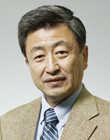Top>Opinion>Chulalongkorn University Celebrates a Hundred Years - Heritage of Kings Rama V and Rama VI -
 Index
Index
Chulalongkorn University Celebrates a Hundred Years
- Heritage of Kings Rama V and Rama VI -
Toshiaki Hasegawa
Professor, Faculty of Economics, Chuo University
Areas of Specialization: International Economic Policy, Interindustry-based Macro Econometric Modelling
How the oldest university in the Kingdom of Siam came to be
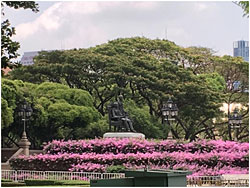
Statue of the two kings who founded Chulalongkorn University
Located in central Bangkok, capital of the Kingdom of Thailand, Chulalongkorn University is renowned as the oldest institute of higher education in the country. The name Chulalongkorn comes from the childhood name of King Rama V (1853–1910), known for modernizing the Kingdom of Siam. In 1899, the king founded the Civil Service Training School as part of his efforts to establish a modern political structure. Three years later, it was renamed the Royal Pages School. When Rama V’s son Vajiravudh became king (Rama VI) in 1910, he founded the Civil Service College of King Chulalongkorn in order to train civil servants. Not long after, in 1917, Chulalongkorn University was created as a way to preserve the former organizations while providing a comprehensive educational institution made up of four departments: the Faculty of Arts and Sciences, the Faculty of Public Administration, the Faculty of Engineering, and the Faculty of Medicine. The founding of the university took place on March 26, exactly one hundred years ago.
Rama V ruled the Kingdom of Siam at a time when the entire Indochina region was under the thumb of colonialism from the great European powers. By ceding a part of the Malay Peninsula to England, which had colonized Burma and Malaysia, and Laos and Cambodia to France, Siam only narrowly managed to maintain its independence.
Japan officially opened diplomatic relations with Siam on September 26, 1887, with the Declaration of Amity and Commerce between Japan and Siam. This was the first time that Japan had been able to establish diplomatic relations with a Southeast Asian country, and this year marks the 130th anniversary of that achievement.
Its fledging beginnings having taken place with the Indochina Peninsula in turmoil, Chulalongkorn University would manage to survive for a hundred years. The institution developed alongside a royal line committed to building a modern state, and today is a fully-fledged university organization complete with nineteen departments and twenty-three colleges and research institutes. In 2016, it was home to 38,941 students and 2,842 faculty members.
A solemn centennial ceremony, performed according to Buddhist rites
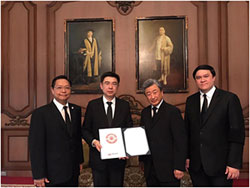
Left to right: Chayodom Sabhasri (former Dean of the Faculty of Economics), Bundhit Eua-arporn (President of Chulalongkorn University), Toshiaki Hasegawa (professor of the Chuo University Faculty of Economics), Worawet Suwanrada (Dean of the Faculty of Economics). Taken in the Mahachulalongkorn Building formal reception room at Chulalongkorn University on March 25, 2017.
On October 13 of last year, just before the university could celebrate its centennial, Rama IX passed. The official mourning period for King Bhumibol was to last a year, so the University Council (Chulalongkorn’s supreme decision-making body) deliberated until the very last moment as to how the centennial ceremony should be held, avoiding extravagance. I heard that many alumni of Chula (as the university is commonly called), who have since made their mark around the world, had been hoping that the ceremony be a massive party.
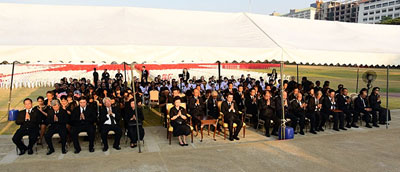
Attendees at the Chulalongkorn University Centennial Ceremony.
I’m seated second from the left in the front row, between the current and former deans of the Faculty of Economics
Final scheduling decisions on the two-day centennial ceremony to be held on March 25 and 26 apparently were not made until that month. I got a message requesting my participation in the event just a couple of weeks in advance. I’ve been interacting with Chulalongkorn University since 2012—more than five years now—in part because of an academic symposium between the faculties of economics at Chulalongkorn and Chuo University that involves my seminar. Every year, thanks to unwavering support from the former dean of the Chulalongkorn Faculty of Economics Chayodom Sabhasri and his staff, I have been involved in a project where I provide guidance to students in my lab who are writing papers in English, leading the twenty-plus students in exchange activities with Chula. This past academic year, the new dean of the Chulalongkorn Faculty of Economics, Worawet Suwanrada, assured me to take over the student exchange. The exchange project is backed by an institutional academic agreement established between our two departments. Starting two years ago, Chulalongkorn also sent a dozen or so students to visit the Chuo University Tama Campus and participate in a similar research symposium. The professors at the Chulalongkorn Faculty of Economics and I spent a great deal of time putting together this exchange framework.
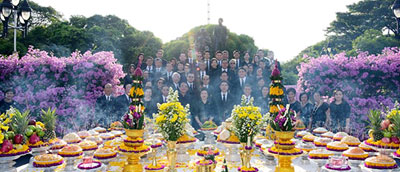
Centennial ceremony attendees with the statues of the two founders (I’m third from the left in the back row)
I’d naturally assumed that the centennial ceremony would be attended by numerous overseas guests. Prior to my visit, it was decided that Chuo University’s Chancellor and President, Shozaburo Sakai would prepare a personal letter of congratulations for me to deliver to the president of Chulalongkorn University, Bundhit Eua-arporn. On the early morning of March 25, the first day of the two-day centennial ceremony and related events, an event of the century was about to start. The university has a formal reception room on the first floor of its Mahachulalongkorn Building that is used to host members of the royal family when they make a visit, and this formal reception room was used for my meeting with the university president just as the centenary events were scheduled to begin. The current and former deans of the Faculty of Economics, Worawet Suwanrada and Chayodom Sabhasri, were also present.
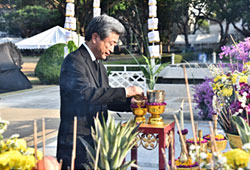
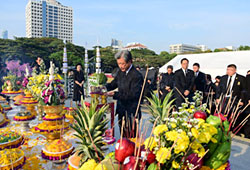
Burning incense on an altar to Rama V and VI
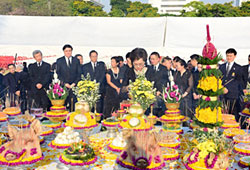
Attendees line up to burn incense following the president of the university
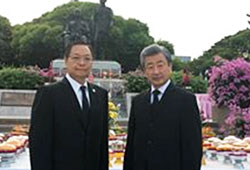
With Chayodom Sabhasri, former Dean of the Faculty of Economics and member of the University Council
On this early morning when all of Chulalongkorn University was rife with anticipation, the leaders of this grand institution were gathered on a balcony surrounding this grand formal reception room, chatting over coffee and simple sandwiches. In addition to the current president, vice president, and numerous deans, the group included distinguished elderly gentlemen that had made key contributions in the history of the university, including its former president. I, the overseas guest, was introduced to one great leader after another to exchange greetings. At half past six, we walked the 200 meters or so to an area in front of the statue of King Chulalongkorn and his son (Rama V and Rama VI). The look of this familiar square at Chulalongkorn University had been completely transformed, decorated with an altar for the occasion, a special table overflowing with offerings. It was the moment when the solemn ceremony would begin under the direction of the officiating Buddhist priest. The people of Thailand practice a form of Theravada Buddhism that came to them via Sri Lanka. It’s quite different from the Mahayana Buddhism practiced in Japan and elsewhere.
There were probably about 120 people in attendance, and all of them played a role in university operations. There were even twenty or so schoolchildren from the elementary school affiliated with the university watching over the proceedings from the rear. The altar was covered in classic Thai Buddhist offerings—everything from fruit and confectionaries to pigs’ heads and crab piled high on platters and bowls. The university president started things off by offering flowers and incense, followed by the remaining participants. Each person lit incense and put it on one of the offerings of his or her choice before returning to their seats. I followed along with the rest, sprinkling holy water on my head and face in a ritual called hosshosui, known in Japan as shasui-kancho, before placing incense in offerings of pork and banana.
This small ceremony held in a symbolic corner of the university was the official start of the Chulalongkorn University centennial celebration. The venue for an event held separately from the official event, where some two thousand alumni would gather on the evening of the second day, was fanning out behind a partition surrounding this altar and ceremony. Preparations—including setting up food stalls and a thousand chairs—were nearly complete. Just past eight o’clock at the morning ceremony, the temperature having risen to 30°C, the sun shone directly on the statues of Rama V and Rama VI as they looked over the attendees. It was an impressive sight in the glimmering light.
A university centennial ceremony officiated by Buddhist priests
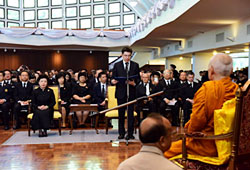
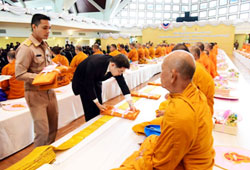
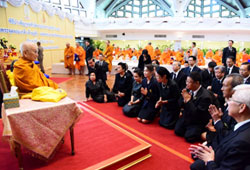
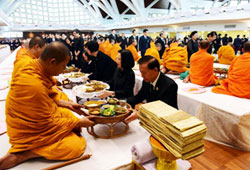
Congratulations and a sermon were offered by the Supreme Patriarch of the Kingdom of Thailand, accompanied by 108 Buddhist monks. This was followed by a meal.
Following the university leaders had formally paid their respects to Rama V and Rama VI, a centennial ceremony was held according Buddhist rites. It took place in an auditorium not far from the Faculty of Economics. The hall was lined with separate red and black seats. The dean of the Faculty of Economics led me to my seat, and 108 Buddhist monks sat in the black seats that had been laid out on the right half of the hall. Finally, the head monk appeared at the venue in order to take his seat at the front, and all of the participants got down on their knees to greet him. The head monk is a great monk holding a position comparable to that of prime minister for life in Thailand. The sound of sutra chants led by the great monk reverberated throughout the hall. When these lengthy incantations were complete, Chulalongkorn University held a banquet to show their gratitude to the monks.
The black seats laid out for the 108 monks in front of where I was seated were Chulalongkorn University seats assigned to the banquet participants, who were to serve trays to the monks’ tables three times. They presented food the first time, followed by dessert, and then a thank-you gift. On this day, I couldn’t tell whether I was meant to be a guest or one of the banquet participants. The honor that had been bestowed upon me in being asked to participate in this ceremony as a friend of the university’s Faculty of Economics finally hit me as I sat in this auditorium. Once the monks had finished their meals, the chairman of the University Council presented each monk with two gifts—first a large fan-shaped Buddhist altar object, and finally a clerical robe.
Although I had presided over Buddhist memorial services for my family back home, I was amazed at this kind of banquet where people sat one-to-one with the monks for service. The participants simply waited in the venue as the monks ate their meals. That meant that the first day of the centennial ceremony when the Buddhist rites were held would finish at lunchtime. In the past, I had heard that Buddhist-style events were mostly held in the mornings in Thailand. The reason turned out to be that the monks were forbidden from eating after noon. One of the Chula professors told me that it was extremely unhealthy for the monks to just sit and keep eating from the beginning to the end of one of these events. The meal was no different than one you would receive in a restaurant. When I told them about the humble meals of white rice, miso soup, and a single side dish that Japanese monks ate, my Thai friends were shocked at the difference. Of course, that can also be a cause of health problems due to poor nutrition.
Day two of the ceremony, held in the presence of Princess Sirindhorn
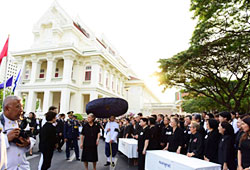
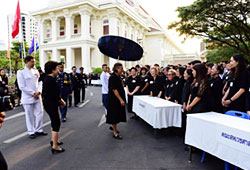
I had an audience with the princess as she approached the Faculty of Economics booth in front of the Mahachulalongkorn Building
Early on the morning of March 26, at six-thirty, preparations had already been made to receive the Princess Maha Chakri Sirindhorn along with numerous monks in the area around the Mahachulalongkorn Building. As a member of the Chulalongkorn University Council , Faculty of Economics professor Chayodom Sabhasri took charge of overseeing this important ceremony. He would later move to the University Council booth. I heard that this was for the sake of planning for the assembly that would greet Princess Sirindhorn. The Permanent Secretary of Finance, Somchai Sujjaponges, who is also a key university advisor, would accompany the princess.
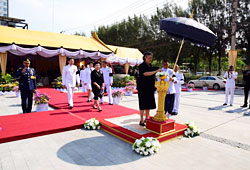
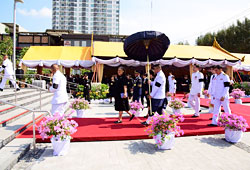
Each university department had its own table, on which it had prepared gifts to present to the monks as alms. The gifts were presented as the monks walked by. A student attended each monk in order to carry the offerings, and they struggled with giant bags so full of gifts that they reminded one of Santa Claus. I stood alongside the corner that had been assigned to the Faculty of Economics as their guest. Professor Somboon, the faculty’s associate dean, took special care of me throughout the event—making sure, as did the current and former deans, that their friend visiting from Japan would know what to do.
As the time neared seven, a large umbrella appeared about 200 meters in the distance, heralding the presence of a noble personage underneath. Princess Sirindhorn, a widely beloved figure among the Thai people, had arrived. Shortly thereafter, she began to draw near to the Faculty of Economics area. It seemed that she sensed the presence of someone a bit out of place as a bowed. She paid a condolence call to the statue of King Chulalongkorn and his son, as the university’s key people did the day before.
Once the greeting of the princess had concluded, we were to move to the ceremony in which the new Chulalongkorn University Centenary Park would be officially dedicated. The park had been constructed on the outskirts of campus for the purpose of this ceremony. Nearly a hundred members of the university leadership gathered at 9:20 AM, and the princess proceeded to observe every corner of the park and numerous tree plantings for an hour in 33°C weather under the blazing sun in order to commemorate the opening of the park. Even those of us who had taken shelter in the tent were suffering from the heat. The Chulalongkorn University centennial ceremony was thus entering its final phase.
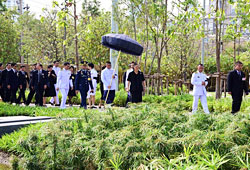
Centenary Park
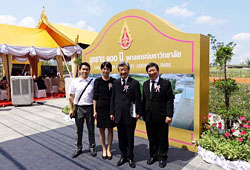
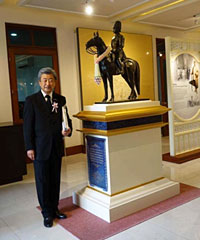
The university’s royal connections are preserved in its museum
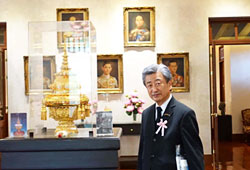
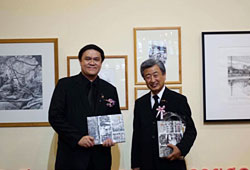
With Dean Worawet Suwanrada at a commemorative exhibition by an artist alumnus
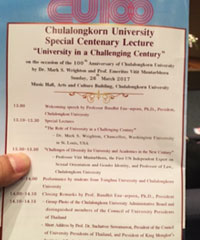
Commemorative lecture in the Faculty of Fine Arts and Culture Building Music Hall
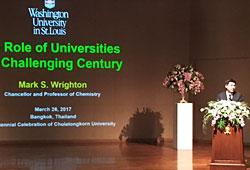
The last event on the second day was a commemorative lecture titled “University in a Challenging Century,” held in the Faculty of Fine Arts and Culture Building Music Hall. Lectures were given by Dr. Mark Wrighton, Chancellor of Washington University in the United States, and by Vitit Muntarbhorn, professor of law at Chulalongkorn University and famed even within the school for his impressive intellect. I was deeply impressed by the commemorative centennial lectures delivered by these two illustrious scholars, and they provided a fitting end to two days of memorable centenary events.
Many graduates had been looking forward to participating in a massive event at the university, so separate plans were made to hold a party for two thousand alumni on the night of the second day, using a campus field overlooked by the kings who had founded the school. Princess Sirindhorn made an appearance on the stage that evening, conspicuously fitted out in a black polo shirt, and the family-like feelings of camaraderie among the Chulalongkorn alumni and volunteer students who participated made it a historic and unforgettable night.
My experiences at the centennial celebration for Chulalongkorn University, in institution whose history dates back to the Kingdom of Siam, were incredibly precious. Though I originally set out to participate as a guest, the university faculty on campus allowed me to be involved in their deeply significant celebration as a friend—and for me, there could have been no greater honor. The events I’ve shared may not seem out of the ordinary for Japanese universities built around departments of Buddhist studies, but I suspect that for many Japanese, these happenings in a country with which we share a friendship stretching back to the Meiji era may seem both interesting and impressive.
Note: Most of the photos in this article were shown with permission by Chulalongkorn University photographer Ms. Pimluck Siriwatcharatorn.
- Toshiaki Hasegawa
Professor, Faculty of Economics, Chuo University
Areas of Specialization: International Economic Policy, Interindustry-based Macro Econometric Modelling -
Professor Hasegawa was born in Hokkaido in 1948. He completed the doctoral program in International Economics at the Graduate School of Keio University. Hasegawa has been an associate professor with Takushoku University; a visiting researcher for the Department of Economics and the Center for International Affairs at Harvard University and Brandeis University; a visiting professor for the People's Republic of China Shaanxi College of Finance and Economics, Peking University, and Tsinghua University; an instructor for the Customs Training Institute of the Ministry of Finance; and a concurrent lecturer at International Christian University and Yokohama National University. He currently serves as a professor for the Faculty of Economics at Chuo University.
Major affiliations
The Japan Society of International Economics
The American Committee on Asian Economic Studies
Pan Pacific Association of Input-Output Studies (PAPAIOS)
The Interindustry Forecasting Project at the University of Maryland (INFORUM)
The International Input-Output AssociationRecent major publications
The Craft of Economic Modeling by C. Almon, co-translator and author of supplement, Nippon Hyoronsha, April 2002
APEC Market Integration [APEC no shijo togo], author and editor, Chuo University Press, 2011
“Asia’s Industrial Structure and Interdependence” [Ajia no sangyokozo to sogoizon], co-author,
Input-Output, Vol. 20, No. 1, 2012
Toshiaki HASEGAWA (editor), Analysis of Macroeconomic Policy in Input-Output Economics, the Institute of Economic Research, Chuo University, April, 2011.
Toshiaki HASEGAWA et al.(editors), Interindustry based Analysis of Macroeconomic Forecasting, Institute for International Trade and Investment, July, 2011.
March 11: Complex Disaster and Challenges for Japan [3.11 Fukugo-saigai to nihon no kadai], co-author, Chuo University Press, 2014
Mega-market Integration in the Asia-Pacific Region [Ajia taiheiyo chiiki no mega-shijo togo], author and editor, Chuo University Press, 2017
- Research Activities as a Member of Research Fellowship for Young Scientists (DC1), Japan Society for the Promotion of Science (JSPS) Shuma Tsurumi
- Important Factors for Innovation in Payment Services Nobuhiko Sugiura
- Beyond the Concepts of Fellow Citizens and Foreigners— To Achieve SDGs Goal 10 “Reduce Inequality Within and Among Countries” Rika Lee
- Diary of Struggles in Cambodia Fumie Fukuoka
- How Can We Measure Learning Ability?
—Analysis of a Competency Self-Assessment Questionnaire— Yu Saito / Yoko Neha - The Making of the Movie Kirakira Megane








